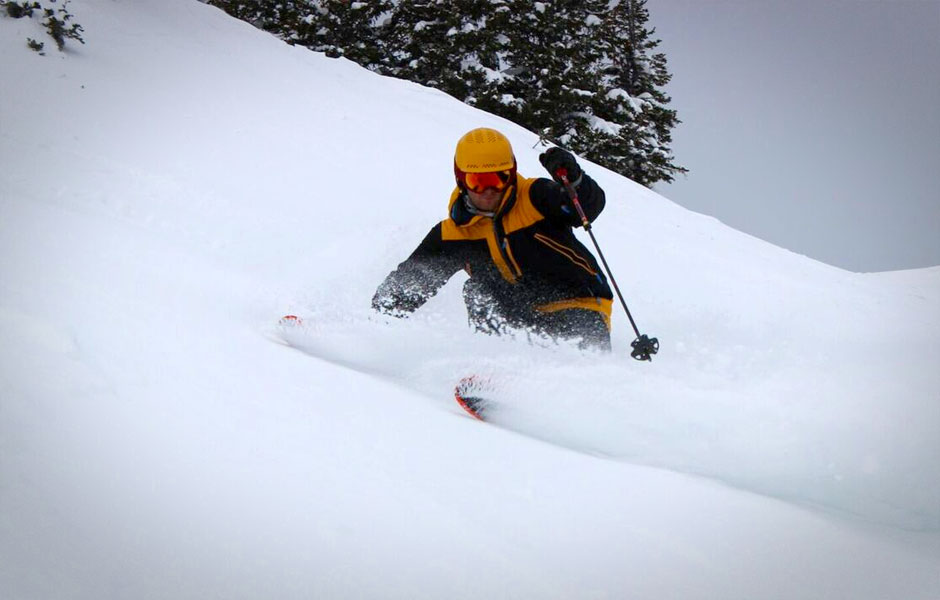
Choosing the right ski clothes involves prioritizing insulation, weatherproofing, and comfort. Opt for garments with a waterproof rating of at least 10,000mm and breathable fabrics. Layers are critical; start with moisture-wicking base layers, add insulating mid-layers, and top with a waterproof, breathable shell. Guarantee clothes fit snugly yet allow full movement, and look for adjustable features like cuffs and hems. Be aware of essential accessories such as gloves, goggles, and neck gaiters for complete protection. Proper care will extend the life of your gear. Mastering these elements enhances your experience on the slopes and assures you stay warm and dry. Further exploration will reveal more tips to optimize your selections.
Table of Contents
Assessing Insulation Needs
When selecting ski clothing, evaluating your insulation needs is essential, as choosing down and synthetic materials significantly impacts warmth and performance in various weather conditions. Down insulation, known for its superior lightweight and compressibility, offers exceptional warmth retention, making it ideal for dry, cold environments where bulk can be minimized. However, its effectiveness diminishes when exposed to moisture since the feathers clump together and lose their insulating properties.
On the other hand, synthetic insulation is engineered for water resistance and maintains warmth even when wet. This makes it particularly suitable for humid or unpredictable weather conditions typical in mountainous terrains. Synthetic fibers are also more durable and less prone to losing loft after compression, which is advantageous during active wear and frequent packing.
Choosing the appropriate insulation type is more than a matter of preference—it’s about matching your specific environmental challenges with the most effective technology available. For those who value freedom in their winter adventures, ensuring that your insulation adapts to varying conditions means uninterrupted enjoyment and performance. Understanding these key differences between down and synthetic insulation will guide you in making a well-informed decision that enhances your experience on the slopes.
Weatherproofing Essentials
How important is weatherproofing in selecting ski clothes for top performance and comfort on the slopes? Ensuring that your outerwear is equipped to handle diverse weather conditions enhances your freedom on the mountain and protects you from the elements, allowing for an uninterrupted skiing experience. Weatherproofing is not just a feature; it’s necessary for any skier who values function and comfort in challenging climates.
Key elements to think about include:
- High Waterproof Ratings: Look for a ski jacket and pants with 10,000mm or more waterproof ratings. This ensures that you stay dry even during heavy snow or rain.
- Sealed Seams: Opt for garments with fully sealed seams to prevent water from seeping through stitch lines, a critical barrier against moisture.
- Breathable Fabrics: Choose materials with breathability ratings of 10,000g or more to allow moisture vapor to escape, keeping you dry from the inside out.
- Durable Water Repellent (DWR) Coating: This adds an extra layer of protection against moisture, ensuring that water beads up and rolls off your clothing.
- Adjustable Features: Features like adjustable hoods, cuffs, and hems help customize your fit and further seal out the cold and wet conditions.
Layering Strategies
Building on the foundation of effective weatherproofing, implementing strategic layering is essential for maintaining ideal body temperature and comfort in varying winter conditions. The first layer, or the base layer top, is pivotal in this system. Opt for moisture-wicking materials such as merino wool or synthetic fibers engineered to draw sweat away from the skin. This keeps you dry and prevents the chilling effect of cold, damp fabric against your body.
Mid layers come next and are your primary source of insulation. Choices range from lightweight fleece, which offers warmth without excessive bulk, to heavier puffy jackets that trap heat efficiently on colder days. The flexibility to add or remove these layers as needed allows you to adapt swiftly to changes in activity level and weather.
Finally, the shell’s outer layers are your armor against the elements. These should be waterproof and breathable to protect from snow and rain while releasing moisture from within. This outermost layer is critical in preserving the integrity of your inner layers by keeping external moisture out.
Together, these layers form a dynamic, adjustable system that ensures you stay warm, dry, and comfortable, allowing you to focus on the freedom and joy of your winter sports activities.
Selecting Ski Accessories
Selecting the right ski accessories, including gloves, neck gaiters, and goggles, is essential for maintaining comfort and enhancing performance in harsh winter conditions. These elements protect you from the cold and improve your freedom and efficiency on the slopes.
Here’s what to keep in mind when choosing essential ski accessories:
- Ski Gloves: Opt for gloves that balance insulation and dexterity. Materials like Thinsulate or Primaloft offer excellent warmth without compromising your ability to grip ski poles or adjust bindings.
- Neck Gaiter: Choose a neck gaiter made from moisture-wicking fabric. This accessory keeps the neck warm and dry, preventing chafing and discomfort while you perform.
- Snow Goggles: Look for goggles with UV protection and an anti-fog coating. Clear vision is important for safety and performance in varying light and weather conditions.
- Water Resistance: Ensure all accessories are windproof and water-resistant to withstand winter elements and effectively maintain ideal body temperature.
- Quality Matters: Invest in high-quality accessories that promise durability and functionality. Better quality means better performance and longer-lasting comfort on the slopes.
Understanding Fit and Comfort
Achieving the right fit and comfort in ski clothing is essential for peak performance and mobility on the slopes. Ski clothes should fit snugly yet allow for a full range of motion, ensuring no discomfort while engaging in vigorous activities. It’s important to select garments that offer flexibility and support, minimizing any restriction that impedes your skiing technique or freedom of movement.
Look for ski clothes with adjustable features such as cuffs, hems, and waistbands. These allow for a more personalized fit, accommodating different body shapes and sizes. They can also be tailored to suit various layering needs depending on weather conditions. Adjustable elements also enhance the garment’s ability to keep out snow and cold air, increasing warmth and comfort.
Furthermore, choosing ski clothes made from stretchy and breathable materials is essential. These fabrics provide the necessary warmth and ensure that moisture from sweat is effectively wicked away, keeping you dry and comfortable. Breathable materials help maintain an ideal body temperature, preventing overheating during intense activities and cooling down periods. Opting for seamless and tagless designs can also greatly enhance comfort by reducing skin irritation and chafing, making your winter adventure more enjoyable.

Maintenance and Care Tips
Proper maintenance and care of ski clothes are essential to preserving their functionality and extending their lifespan. This guarantees that they remain effective in keeping you warm and dry during winter activities. Following the right procedures protects your investment and enhances your freedom and enjoyment on the slopes.
Here are five key tips for maintaining your ski apparel:
- Follow Manufacturer’s Care Instructions: Always check the labels inside your ski clothes for specific care guidelines to guarantee peak performance and durability.
- Regularly Wash and Dry: Clean your ski garments after use to remove dirt and sweat that can affect the fabric’s qualities. Always wash and dry according to the manufacturer’s recommendations.
- Use Gentle Detergent: Opt for a detergent designed for technical fabrics to avoid damaging the materials. Gentle detergents help maintain the integrity of the waterproofing and breathability features.
- Avoid Fabric Softeners and Bleach: These products can degrade the fabric’s performance characteristics, including its ability to repel water.
- Store Properly: When not in use, keep your ski clothes in a cool, dry place away from direct sunlight to prevent degradation and extend their life for future seasons.
Shopping for Ski Clothes
When shopping for ski clothes, consider the specific weather conditions of your destination to guarantee maximum warmth and protection. Start with a high-quality ski jacket that offers both waterproof and breathable properties. This will help you stay dry from external moisture and ensure that sweat evaporates quickly, keeping you comfortable throughout your activities. The jacket should have features like a helmet-compatible hood and adjustable cuffs, enhancing functionality while on the slopes.
Next, consider ski pants that complement the protection offered by your jacket. Look for pants with similar waterproof and breathable characteristics. Ensure they fit well over your boots and provide enough flexibility for movement.
Layering is essential for maintaining the ideal body temperature. Begin with a moisture-wicking base layer that keeps your skin dry. Add a mid-layer, such as a fleece or a synthetic down jacket, which provides insulation to stay warm without adding bulk. This system allows you to adjust your layers according to the weather and activity level, maximizing your performance and enjoyment on the slopes. Always check for specialized pockets to store essentials like lift passes and goggles conveniently.





